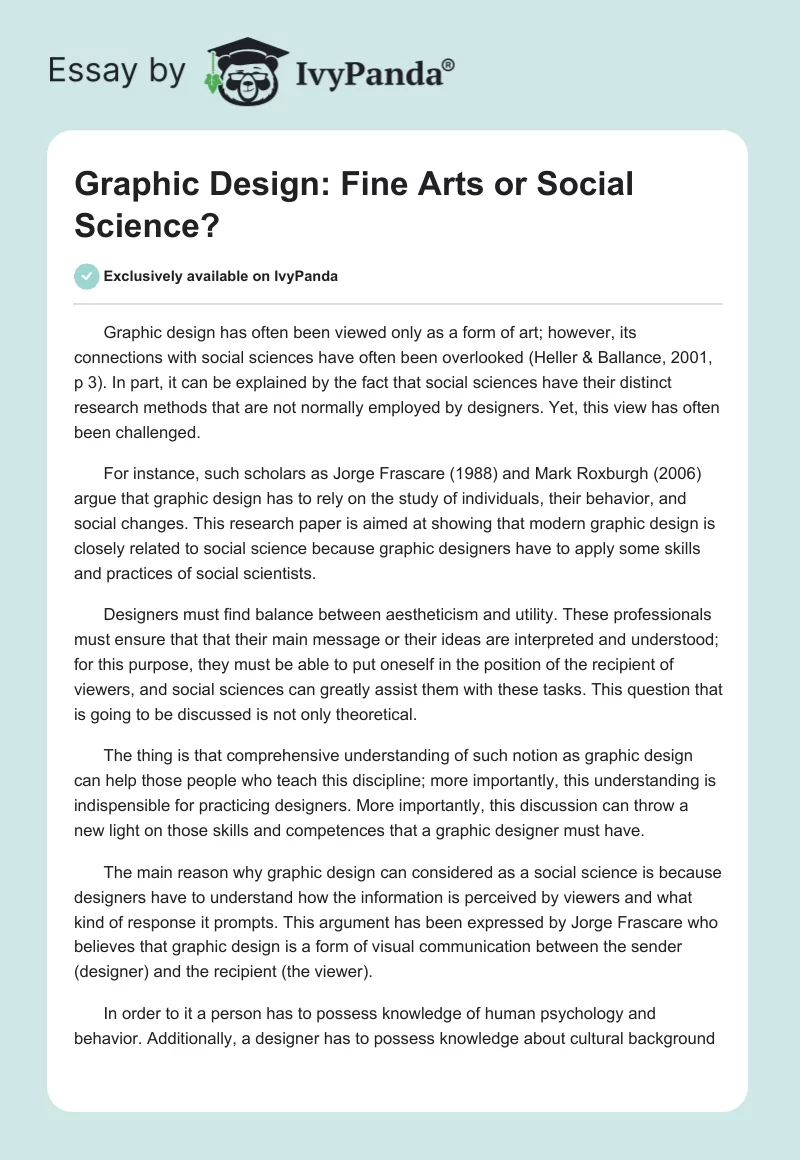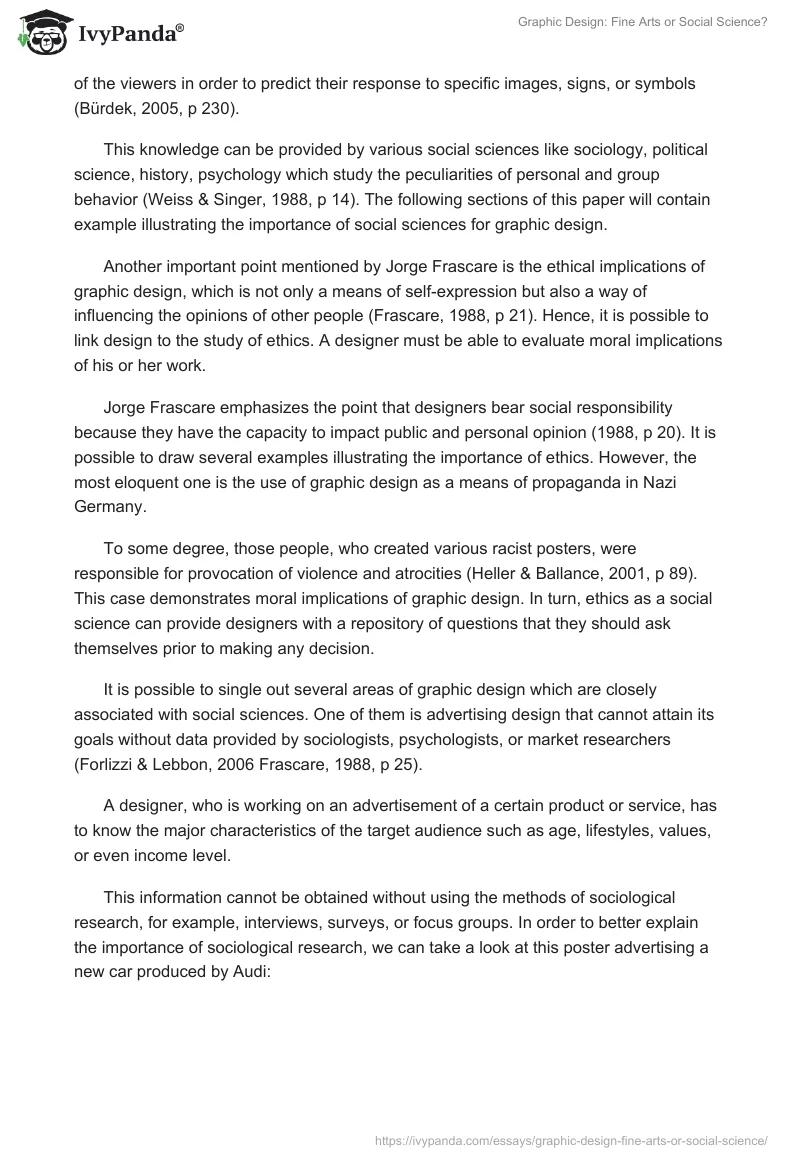Graphic design has often been viewed only as a form of art; however, its connections with social sciences have often been overlooked (Heller & Ballance, 2001, p 3). In part, it can be explained by the fact that social sciences have their distinct research methods that are not normally employed by designers. Yet, this view has often been challenged.
For instance, such scholars as Jorge Frascare (1988) and Mark Roxburgh (2006) argue that graphic design has to rely on the study of individuals, their behavior, and social changes. This research paper is aimed at showing that modern graphic design is closely related to social science because graphic designers have to apply some skills and practices of social scientists.
Designers must find balance between aestheticism and utility. These professionals must ensure that that their main message or their ideas are interpreted and understood; for this purpose, they must be able to put oneself in the position of the recipient of viewers, and social sciences can greatly assist them with these tasks. This question that is going to be discussed is not only theoretical.
The thing is that comprehensive understanding of such notion as graphic design can help those people who teach this discipline; more importantly, this understanding is indispensible for practicing designers. More importantly, this discussion can throw a new light on those skills and competences that a graphic designer must have.
The main reason why graphic design can considered as a social science is because designers have to understand how the information is perceived by viewers and what kind of response it prompts. This argument has been expressed by Jorge Frascare who believes that graphic design is a form of visual communication between the sender (designer) and the recipient (the viewer).
In order to it a person has to possess knowledge of human psychology and behavior. Additionally, a designer has to possess knowledge about cultural background of the viewers in order to predict their response to specific images, signs, or symbols (Bürdek, 2005, p 230).
This knowledge can be provided by various social sciences like sociology, political science, history, psychology which study the peculiarities of personal and group behavior (Weiss & Singer, 1988, p 14). The following sections of this paper will contain example illustrating the importance of social sciences for graphic design.
Another important point mentioned by Jorge Frascare is the ethical implications of graphic design, which is not only a means of self-expression but also a way of influencing the opinions of other people (Frascare, 1988, p 21). Hence, it is possible to link design to the study of ethics. A designer must be able to evaluate moral implications of his or her work.
Jorge Frascare emphasizes the point that designers bear social responsibility because they have the capacity to impact public and personal opinion (1988, p 20). It is possible to draw several examples illustrating the importance of ethics. However, the most eloquent one is the use of graphic design as a means of propaganda in Nazi Germany.
To some degree, those people, who created various racist posters, were responsible for provocation of violence and atrocities (Heller & Ballance, 2001, p 89). This case demonstrates moral implications of graphic design. In turn, ethics as a social science can provide designers with a repository of questions that they should ask themselves prior to making any decision.
It is possible to single out several areas of graphic design which are closely associated with social sciences. One of them is advertising design that cannot attain its goals without data provided by sociologists, psychologists, or market researchers (Forlizzi & Lebbon, 2006 Frascare, 1988, p 25).
A designer, who is working on an advertisement of a certain product or service, has to know the major characteristics of the target audience such as age, lifestyles, values, or even income level.
This information cannot be obtained without using the methods of sociological research, for example, interviews, surveys, or focus groups. In order to better explain the importance of sociological research, we can take a look at this poster advertising a new car produced by Audi:

This poster is supposed to appeal to predominantly well-to-do male customers, who value luxury brands since they emphasize their status in society. As a matter of fact the designer emphasized this car model is particularly intended for prosperous people who are not price-sensitive. This design would have been impossible without analysis of demographic data about the specific target audience. Thus, we can say that a graphic designer at least has to rely on the information that social sciences can give him or her.
One has to acknowledge that designers are not responsible for the collection of this demographic data; yet, they make decisions on the basis of this information. This example shows the importance of social science for advertising design. At this point, we can suggest that modern graphic design is based on interdisciplinary research methods, and that it cannot be viewed only from aesthetic perspective. Artistic component is certainly indispensible for graphic design, but it is not the only one.
Another important area of graphic design which illustrates the importance of social sciences is page layout. The main task of a designer is to determine the position of different elements on a printed or electronic page. Page layout has to capture the viewers’ attention and subsequently make them read and remember the specific message that the designer intends to convey.
To achieve this goal, one should take into consideration several issues, for example, the peculiarities of color perception, and this is domain of psychology which is also a social science. To better illustrate this argument, we can look at the cover of the Sunday Time Magazine.

The designer uses three different font colors in order to highlight some important news or ideas. For instance, by using yellow color the designers sets stress on the idea that this newspaper has changed its outlook and that it will bring new experiences to the reader. It should be noted that this choice is not accidental.
The thing is that yellow is one of the most visible colors, and it is very likely to capture the viewers’ attention (Graham, 2005, p 195). Again, this knowledge is closely related to such social science as psychology.
Design of instructions, traffic signs, and warnings is another example which shows close connections between and graphic design and social science. In this case, the main task is to create a clear and specific message to a person. These signs must be noticeable and understandable to people, who may speak different languages and belong to different cultures.
In order to cope with this task, a designer must rely on semiotics, a science which studies the way in which people use and understand signs and symbols (Bürdek, 2005, p 230). The following image can better illustrate this argument:

This sign is intended primarily for the native speakers of English; however, it can be understood by people, who do not understand this language. The designer achieves this effect by using lightning symbol which is cross-cultural. These cross-cultural symbols are studied by semiotics.
A person does not to possess knowledge of any foreign language in order to see that this poster signified danger. In this case, artistic component is not of the greatest importance because the main task is to inform the view about danger rather than impress him or her.
The examples which have been discussed in the previous section show that modern graphic design cannot be separated from social sciences. The work of designers cannot be viewed only from aesthetic point of view, since such perspective does not fully reflect the tasks of these people.
They should possess a variety of skills and competences and some of them are closely connected with psychology, sociology, and other social science. The education of graphic designers should rely on these sciences, and such scholar as Steven Heller believes that the design curriculum has to include them (2005, p 29).
It has to be admitted that for a long time designers did not rely on social sciences but it greatly diminished the efficiency of their work. Graphic design cannot be reduced to pure aestheticism, since it has to bring some utility to people.
On the whole, this discussion is not aimed at downgrading the importance of aesthetic component; instead it seeks to demonstrate that graphic design is a much more complex notion comprising a great number of elements. As it has been said before, graphic design is a form of communication between groups and individuals. Thus, a graphic designer has to understand the laws of this communication in order to do one’s work effectively.
In his article Jorge Frascare (1988) argues that those designers, who overemphasize the artistic element of their work and underestimate the importance of social sciences, often fail to convey their ideas to the viewers (p 22). This is the main reason why this topic can be of great importance to people, who have chosen this profession.
Strong connections between graphic design and social sciences cannot be disregarded. Graphic designers have to possess a great number of skills and competences, which are closely different social science like psychology, sociology, semiotics, and many others. As it has been argued before, graphic design is a form of communication between people, and one has to understand the rules governing the process of communication in order to be a good designers.
Therefore, one can say that graphic design is not only a fine art, but a social science as well since it relies on the study of human behavior, interactions, culture, and perception of information. The point is that graphic design cannot be reduced only to artistic component because such perception will prevent will not allow graphic designers do their work effectively.
Reference List
Audi USA (2009) Audi RB advertisement. Web.
Bürdek. B. (2005) Design: history, theory and practice of product design. Munich Birkhäuser.
Forlizzi, J., & Lebbon, C. (2006) From formalism to social significance in communication design. In: Design studies: Theory and research in graphic design. Ed. Audrey Bennet. New York City, NY: Princetown Educational Press, 51-84.
Frascara, J. (1988) Graphic design: Fine art or social science? Design Issues, 5 (1), 18-29.
Graham L. (2005). Basics of design: layout and typography for beginners. NY: Cengage Learning.
Heller, S. (2005) Design as a liberal art versus design plus liberal arts. In:The education of a graphic designer. New York City, NY: Allworth Communications, Inc.
Heller S. & Ballance G. (2001). Graphic design history. NY: Allworth Communications, Inc.
MySafetySign. (2011) Warning Sign: High Voltage. Web.
The Guardian. (2008) The Cover of The Sunday Times. Web.
Roxburn, M. (2006) The utility of design vision and the crisis of the artificial. In: Design studies: Theory and research in graphic design. Ed. Audrey Bennet. New York City, NY: Princetown Educational Press, 147-179.
Weiss C. & Singer E. (1988). Reporting of social science in the national media. NY: Russell Sage Foundation.


